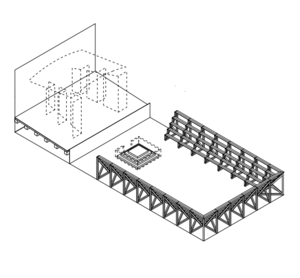Difference between revisions of "Sabbattini in 3D"
From CanonBase
m |
m |
||
| (3 intermediate revisions by the same user not shown) | |||
| Line 1: | Line 1: | ||
| − | Nicola | + | Nicola Sabbatini published in 1637 the influential book ''Pratica di fabricar scene e machine ne' teatri''. Written in old Italian and poorly illustrated, it's difficult to access for students. We have expanded the book with a new and complete 3d drawing of Sabbatini's theatre - a digital model to achieve a more visual way to understand the theatre space and the machinery of the Baroque Theatre, and therefore a better understanding for the students of the history of theatre. |
| − | machine ne | + | |
| − | |||
| − | |||
| − | theatre space and the machinery of the | ||
| − | understanding for the students of the | ||
[[File:Sabbattini in 3d.png|thumb]] | [[File:Sabbattini in 3d.png|thumb]] | ||
| − | |||
| − | |||
| − | |||
=== Credits === | === Credits === | ||
| − | An ongoing research by Antoni Ramon and Guillem Aloy. The drawings were | + | An ongoing research by Antoni Ramon and Guillem Aloy. The drawings were developed by Pol Monjo Roca. |
Latest revision as of 12:47, 2 June 2023
Nicola Sabbatini published in 1637 the influential book Pratica di fabricar scene e machine ne' teatri. Written in old Italian and poorly illustrated, it's difficult to access for students. We have expanded the book with a new and complete 3d drawing of Sabbatini's theatre - a digital model to achieve a more visual way to understand the theatre space and the machinery of the Baroque Theatre, and therefore a better understanding for the students of the history of theatre.
Credits
An ongoing research by Antoni Ramon and Guillem Aloy. The drawings were developed by Pol Monjo Roca.
